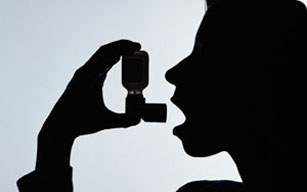 Asthma is a chronic inflammatory disease of the airways. In the US, over 25 million people suffer from asthma. About 7 million of these people are children.
Asthma is a chronic inflammatory disease of the airways. In the US, over 25 million people suffer from asthma. About 7 million of these people are children.
Asthma is a disease that causes severe attacks of wheezing and coughing. Although asthma cannot always be prevented, it can be controlled with the right medicine and information.
Signs of Asthma
If your child has any of the following problems, he or she may have asthma.
- Wheezing that begins suddenly, may be worse at night or in early morning or may get worse when exposed to cold air
- Coughing
- Chest tightness or pain
- Shortness of breath
- Excess mucus
Other symptoms that are sometimes linked with asthma may include stuffy or runny nose, sinus problems or nasal polyps (growths inside the nose).
Asthma Triggers
Everyday life is filled with the allergens that can kick off an asthma attack. Some of the more common factors or triggers are:
- Allergic reactions from pollens, feathers, molds, animals, some foods, house dust
- Emotional stress/excitement, fear or laughter
- Vigorous exercise, especially when it leads to overexertion or in cold weather
- Cold air, wind, rain or sudden changes in the weather
- Occupational dusts and vapors
- Air pollution. Look at today's air quality maps to see the levels of air pollution in your area.
- Sleep (nocturnal asthma)
Diagnosing and Treating Asthma
Diagnosing asthma is based on a physical examination and a personal history. The personal history will include any history of breathing problems you may have had, as well as a family history of asthma, allergies, eczema or other lung disease. It is important that you describe your symptoms in detail (coughing, wheezing, shortness of breath, chest tightness), including when and how often these have been occurring.
A physical examination looks for signs of wheezing, shortness of breath, or coughing. Tests such as chest x-rays and pulmonary function tests may be done to confirm your diagnosis.
If you are diagnosed with asthma, you can avoid having an attack by taking your medicine exactly as your doctor says and by avoiding your asthma triggers. Creating your own Asthma Action Plan can help manage you or your child’s asthma in a way that best works for you!
Allergies
The most common allergic conditions:
- Allergic rhinitis (hay fever) describes the lining of the nose when it becomes inflamed (red and swollen). People with this condition usually complain of an itchy, stuffy or drippy nose, a scratchy throat, and coughing. Persistent sneezing, coughing, and an itchy throat may be signs of allergic rhinitis.
- Allergic Conjunctivitis is an allergic reaction on the surface of the eyes and eyelids caused by allergens. Itching is the most common symptom although other symptoms include redness, tearing, swelling, burning or a sensation of fullness in the eyes or eyelids, an urge to rub the eyes, sensitivity to light and occasionally blurred vision.
- Urticaria (hives) is the medical word for hives. Hives, or "wheals", are pale red swellings of skin that occur in groups on any part of the skin. Each hive lasts a few hours before fading without a trace. New areas may develop as old areas fade. They can vary in size from as small as a pencil eraser to as large as a dinner plate and may join together to form larger swellings. Hives usually are itchy, but may also burn or sting.
- Atopic Dermatitis (eczema) is a chronic skin disorder categorized by scaly and itching rashes. People with eczema often have a family history of allergic conditions like asthma, hay fever or eczema.
- Allergens are substances that normally cause allergies, such as pollen from grasses, trees, and weeds, animal dander, dust mites, cockroaches, air pollutants (dust, smog, tobacco smoke, wood smoke), strong sprays from perfumes, paints, household cleaners, talcum powder and chalk dust.
Resources:
